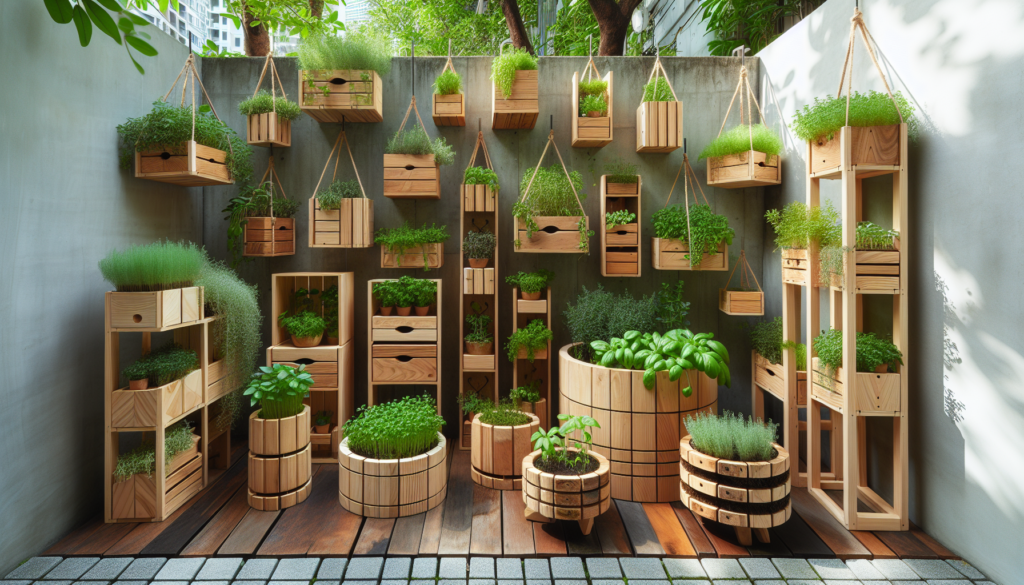Imagine having your own wooden herb garden, right in your backyard. It’s not only a beautiful addition to your outdoor space, but it also provides easy access to fresh herbs for all your culinary creations. From compact vertical gardens to rustic planter boxes, there are endless ideas for creating a wooden herb garden that suits your style and space. And if you’re feeling particularly crafty, why not try your hand at building a wooden recipe box to store all your favorite recipes? It’s a practical and charming project that adds a touch of nostalgia to your kitchen. Get ready to unleash your creativity and enjoy the flavors of your very own herb garden!

Benefits of a Wooden Herb Garden
Eco-friendly
When it comes to gardening, choosing a wooden herb garden is not only a great way to enhance your outdoor space, but it also offers several eco-friendly benefits. Wood is a renewable resource, making it a sustainable choice for your herb garden. By opting for wooden materials, you are promoting the use of natural resources and reducing your carbon footprint. Additionally, wooden herb gardens are biodegradable, ensuring that they will not end up in landfills and contribute to environmental waste.
Enhances Aesthetics
One of the key advantages of a wooden herb garden is its ability to enhance the aesthetics of your outdoor space. With their natural warmth and timeless appeal, wooden structures add a touch of rustic charm to any garden setting. Whether you have a sprawling backyard or a compact balcony, a wooden herb garden can complement any landscape or design style. It provides a visually pleasing backdrop for your vibrant herbs and adds character to your overall garden ambiance.
Durable and Long-lasting
Wooden herb gardens offer durability, ensuring that your gardening endeavors will stand the test of time. When properly maintained, wooden structures can withstand various weather conditions, including exposure to sunlight, rain, and snow. The natural strength of woods like cedar, redwood, oak, and pine makes them resistant to rot and decay. By investing in a wooden herb garden, you are creating a long-lasting space that you can enjoy for years to come.
Choosing Suitable Wood for Herb Gardens
Cedar Wood
Cedar wood is a popular choice for herb gardens due to its natural resistance to decay and insects. Its aromatic properties also deter pests, making it an excellent option for those looking to keep their herbs safe from unwelcome visitors. Cedar wood tends to have a rich and appealing reddish hue, adding an attractive touch to your garden space. Its natural oils help preserve the wood, ensuring that your herb garden remains durable and visually appealing.
Redwood
Known for its exceptional durability and resistance to rot, redwood is another suitable wood for herb gardens. It has a beautiful reddish-brown color that mellows over time, giving your garden a sophisticated and timeless look. Redwood also contains natural oils and tannins that protect the wood from decay and insect damage. By choosing redwood for your herb garden, you are investing in a durable material that will maintain its beauty for years to come.
Oak
If you prioritize strength and longevity, oak is a fantastic choice for your herb garden. Oak wood is known for its exceptional hardness and toughness, making it highly resistant to wear and tear. Its natural resistance to decay and insect infiltration ensures that your herb garden will remain sturdy and visually appealing. Oak has a beautiful grain pattern and a warm, reddish-brown color that adds a touch of elegance to your outdoor space.
Pine
For those on a budget, pine wood offers an affordable option without compromising on quality. Pine is widely available and easy to work with, making it an excellent choice for DIY herb garden projects. While not as naturally resistant to decay as cedar or redwood, pine can still be used effectively with proper maintenance. By applying protective coatings and regular inspections, you can ensure the durability of your pine herb garden. Its light color and distinct grain pattern add a charming rustic feel to your garden space.
Design Ideas for Wooden Herb Gardens
Tiered Herb Garden
A tiered herb garden is an excellent design idea for maximizing space while adding visual interest to your outdoor area. This design utilizes multiple levels or tiers of wooden planters, creating a cascading effect. You can choose to have the tiers arranged in a symmetrical or asymmetrical pattern, depending on your preference. This design not only allows you to grow multiple herbs in a small space but also adds dimension and depth to your herb garden.
Vertical Herb Wall
For those with limited horizontal space, a vertical herb wall is a perfect solution. This design idea utilizes vertical wooden panels or trellises to create a lush and vibrant display of herbs. By attaching small wooden troughs or pots to the panels, you can create a stunning living wall of herbs. Not only does this save space, but it also adds a unique and eye-catching feature to your garden or balcony.
Hexagonal Planter Boxes
If you’re looking for a design that is both functional and visually appealing, consider hexagonal planter boxes. These wooden planters have a six-sided shape, offering a geometric and modern touch to your herb garden. By arranging the hexagonal planters in a cluster or pattern, you can create a focal point that beautifully showcases your herbs. This design idea works well in both large and small garden spaces and adds an element of sophistication to your outdoor area.
Creating Raised Wooden Herb Beds
Selecting Bed Size and Shape
When creating raised wooden herb beds, it is essential to consider the size and shape that best suits your needs and available space. The bed should be wide enough to accommodate the root systems of your herbs while allowing for proper air circulation. The length of the bed can vary, depending on the number of herbs you plan to grow. Rectangular beds are the most common shape, but you can also explore circular or curved designs for a unique look.
Preparing the Soil
Before building your raised bed, it is crucial to prepare the soil to create a healthy growing environment for your herbs. Remove any rocks, weeds, or grass from the area where the bed will be placed. Loosen the soil with a garden fork or tiller and amend it with organic matter such as compost or well-rotted manure. This will enrich the soil and provide essential nutrients for your herbs.
Building the Raised Bed
To build a raised wooden herb bed, start by selecting the appropriate wood, such as cedar or redwood, that is resistant to rot and insects. Cut the wood to your desired dimensions, ensuring that the bed will be deep enough to support the root systems of your herbs. Secure the corners of the bed using galvanized screws or nails, making sure it is sturdy and level. Place the raised bed in your desired location, ensuring it receives adequate sunlight for your herbs to thrive.

Container Gardening with Wooden Pots
Choosing the Right Wooden Pots
When opting for wooden pots for container gardening, it is essential to choose the right ones to ensure the health and growth of your herbs. Select pots made from rot-resistant wood, such as cedar or redwood. Consider the size of the pots, ensuring they provide enough space for the herbs’ root systems to develop. Additionally, ensure the pots have proper drainage holes to prevent waterlogging and root rot.
Adding Drainage Holes
Proper drainage is vital for the success of your container herb garden. Using a drill, add drainage holes to the bottom of the wooden pots. This will allow excess water to drain out and prevent the herbs’ roots from sitting in standing water. Adequate drainage promotes healthy root growth and prevents the risk of root diseases caused by waterlogged conditions.
Properly Sealing the Wood
To protect the wooden pots from moisture damage and extend their lifespan, it is essential to seal the wood properly. Apply a sealant or waterproofing agent to the pots, ensuring that it covers all surfaces, including the inside. This will create a barrier that prevents water from penetrating the wood. Regularly inspect and reapply the sealant as needed to maintain the pots’ integrity and ensure their durability throughout the seasons.
Incorporating Trellises and Lattice Panels
Types of Trellises for Herbs
Incorporating trellises into your wooden herb garden not only adds a decorative element but also provides support for climbing herbs. There are various types of trellises you can choose from, depending on your design preference and the specific herbs you plan to grow. Traditional wooden trellises with crisscross patterns are a classic choice, while modern wire or metal trellises can provide a contemporary touch. Ensure that the trellis material is sturdy enough to support the weight of your climbing herbs.
Building and Installing Lattice Panels
Lattice panels are a versatile addition to your wooden herb garden, offering both privacy and a framework for climbing plants. To build and install lattice panels, start by selecting the appropriate size and material. Wooden lattice panels are a popular and visually appealing choice. Attach the panels securely to wooden posts or framing, ensuring that they are level and properly anchored. You can choose to paint or stain the lattice panels to match your garden’s aesthetic.
Training Herbs to Climb
Once you have installed trellises or lattice panels in your herb garden, it is important to train the climbing herbs to grow vertically. Gently tie the stems of the herbs to the trellis or lattice using garden twine or soft plant ties. Regularly check the plants to ensure they are properly supported and adjust the ties as needed. As the herbs grow, gently guide the stems along the trellis, encouraging them to climb and form a lush and beautiful display.

Utilizing Hanging Wooden Planters
Choosing Hanging Planter Styles
Hanging wooden planters are a fantastic option for those with limited space or for adding a dynamic element to your garden. When choosing hanging planter styles, consider the overall design and theme of your herb garden. Classic wooden baskets or crates provide a rustic and traditional look, while modern wooden planters with sleek lines offer a contemporary feel. Ensure that the hanging planters have sturdy hooks or chains to support the weight of the herbs and soil.
Mounting and Securing the Planters
Properly mounting and securing the hanging planters is essential to prevent accidents and ensure the safety of your herbs. Before mounting the planters, locate a suitable spot that receives the required amount of sunlight for your herbs. Secure hooks or brackets to sturdy structures, such as porch ceilings or sturdy trees. Hang the wooden planters using strong chains or durable ropes, ensuring that they are level and stable. Regularly check the hanging planters to ensure they are properly secured and adjust as needed.
Ideal Herbs for Hanging Planters
While many herbs can thrive in hanging planters, some are particularly well-suited for this type of gardening. Herbs with trailing or cascading growth habits, such as trailing rosemary, thyme, or trailing nasturtiums, are excellent choices for hanging planters. These herbs not only gracefully spill over the sides of the planters but also create a stunning visual display. Additionally, herbs like mint or lemon balm are vigorous growers and can be contained within hanging planters, preventing them from overtaking your garden.
Constructing a Wooden Herb Spiral
Understanding Herb Spiral Design
A wooden herb spiral is a visually striking and efficient way to grow a wide variety of herbs in a small space. This design concept utilizes a spiral-shaped structure, with ascending levels for planting herbs. The spiral design allows for different microclimates within the garden, creating optimal growing conditions for various herbs. The higher levels of the spiral receive more sunlight and have better drainage, while the lower levels provide a moister environment for herbs that prefer shade or more moisture.
Building and Filling the Spiral
To construct a wooden herb spiral, begin by selecting suitable wood, such as rot-resistant cedar or redwood. Lay out the desired shape and size of the spiral using stakes and string as guides. Build the outer wall of the spiral using stacked wooden boards or rocks, ensuring stability and symmetry. Fill the spiral with a well-draining soil mix, incorporating organic matter and compost for added nutrients. Start planting the herbs, placing those that prefer drier and sunnier conditions on the higher levels and those that thrive in shade or more moisture on the lower levels.
Care and Maintenance Tips
Maintaining a wooden herb spiral involves regular care and attention to ensure optimal growth and productivity. Water the herbs deeply and consistently, taking into account the varying moisture needs of the different levels. Fertilize regularly with organic matter or compost, replenishing nutrients as needed. Prune and harvest the herbs regularly to encourage continuous growth and prevent overcrowding. Keep an eye out for pests and diseases, promptly addressing any issues to maintain the health of your herbs.

Adding Water Features to Wooden Herb Gardens
Small Wooden Fountain
A small wooden fountain can add a serene and soothing element to your herb garden. The gentle sound of flowing water creates a peaceful ambiance while attracting birds and beneficial insects. Choose a wooden fountain that complements the overall style of your garden, whether it’s a traditional tiered design or a modern, minimalist structure. Place the fountain near your herb beds, allowing the sound and sight of water to enhance your gardening experience.
Bubbling Water Feature
A bubbling water feature adds a playful and whimsical touch to your wooden herb garden. This type of feature typically consists of a container or basin filled with water, with a small pump that creates bubbles or ripples on the water’s surface. To incorporate a bubbling water feature, select a wooden container that suits your garden’s aesthetics and complements the surrounding herbs. Position the feature strategically, ensuring it is easily accessible and visible from your desired viewing area.
Miniature Pond
For those looking to create a more elaborate water feature, a miniature pond can be an enchanting addition to your wooden herb garden. To create a small wooden pond, dig a hole in the ground and line it with a pond liner or waterproof material. Build a wooden frame or edging around the pond, securing it firmly in place. Fill the pond with water and add aquatic plants and fish to complete the ecosystem. The sight of lush greenery, colorful fish, and the gentle sound of water will create a tranquil oasis within your herb garden.
Maintaining and Preserving Wooden Herb Gardens
Regular Inspection and Cleaning
To ensure the longevity and aesthetics of your wooden herb garden, regular inspection and cleaning are essential. Inspect the wood for signs of decay, rot, or pest infestation, addressing any issues immediately. Clean the wooden surfaces with a gentle cleaner or a mixture of water and mild soap to remove dirt, debris, or stains. Regularly remove fallen leaves, herbs, or other plant material from the wooden structures to prevent moisture buildup and the risk of rot.
Applying Protective Coatings
Applying protective coatings to your wooden herb garden is a key step in preserving its durability and resistance to the elements. Opt for a wood sealant or outdoor wood stain that provides protection against UV rays, moisture, insects, and fungal growth. Ensure that the coating is specifically formulated for exterior use and is safe for edible plants. Apply the protective coating according to the manufacturer’s instructions, periodically reapplying as needed to maintain the wood’s integrity and appearance.
Preventing Rot and Pest Infestations
Preventing rot and pest infestations in your wooden herb garden requires proactive measures. To prevent rot, ensure proper drainage by choosing well-draining soil and avoiding overwatering. Regularly inspect the wooden structures for any signs of decay or damage, addressing any issues promptly. To prevent pest infestations, regularly monitor your herbs for signs of pests such as aphids, slugs, or snails. Implement organic pest control methods, such as using companion plants, handpicking pests, or applying insecticidal soaps when necessary.
In conclusion, a wooden herb garden offers numerous benefits, including eco-friendliness, enhanced aesthetics, and durability. By choosing suitable wood, incorporating creative designs, and utilizing proper maintenance techniques, you can create a beautiful and productive herb garden that will bring you joy for years to come. Whether you opt for raised beds, hanging planters, trellises, or water features, a wooden herb garden is a versatile and charming addition to any outdoor space. Let your creativity soar, and enjoy the rewards of growing fresh, aromatic herbs right in your own backyard or balcony.
As for a project suggestion, a wooden recipe box would be a wonderful addition to any kitchen. You can construct a recipe box using durable and aesthetically pleasing wood, such as cedar or redwood. Consider incorporating dividers to organize your recipe cards and a hinged lid for easy access. Customize the design by engraving or painting your favorite herbs or kitchen motifs on the box’s exterior. This project not only provides a practical storage solution for your cherished recipes but also allows you to showcase your woodworking skills and add a personal touch to your kitchen decor.

